Total Solar Eclipse 2006 Turkey
Before the total eclipse I've checked several websites about solar eclipse photography. Since those pages helped me a lot I collect my experience here. It might be useful for others (or for myself later).
Place, time
March 29, 2006. The solar eclipse was visible from several places (a detailed map can be found here), Turkey was the closest place to Hungary. Our observation point was at Side (close to Manavgat).
Filter
We need a special filter for the solar photography (except the totality). I was using Baader Astrosolar Safety Film (I bought it in a local shop). I've created a filter using this film, it looks very fragile I had to put it into a small box to keep it safe during transportation.
Warning
Staring directly at the Sun (except the totality) without a solar filter is dangerous. Do not do that.
Multiple Exposure Sequence
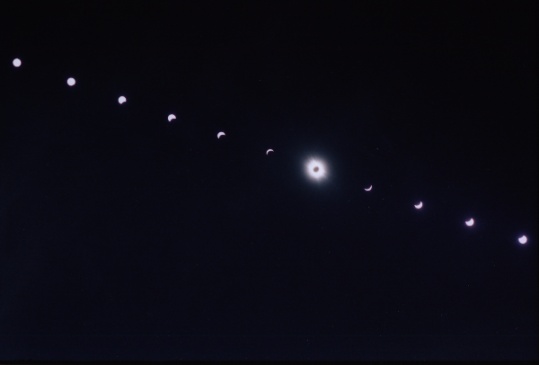
This photo shows several pictures of the partial phase and the totality in the middle. No digital editing, no post-processing, the picture is taken on a single negative.
Equipment
We need a camera which supports multiple exposures (without advancing the film). I was using a Revue AC-5 camera (basically it is Chinon CP-7m). I was using standard 50mm lens (SMC PENTAX-A 50mm f2).
ISO 400 negative, aperture f8, exposure time for the partial phase is 1/30s, for the totality it is 1/2s. The delay between the exposures is 15 minutes. A sturdy tripod is a must, I was protecting it (for 2.5 hours) nobody should move it.
Preparation
It is possible to create test exposure sequence pictures of the Sun before the solar eclipse. I've tested my filter and determined the following parameters:
- Aperture: First I tried F8 (F8 and be there) and the results were good. I've also tried F22 but the Sun was not too nice (because of the diffraction)
- Exposure time (partial phase): According to my tests -1 EV exposure compensation resulted the best images. Exposure metering suggested 1/15s so I was using 1/30s. Although several web page suggests using different (longer) values closer to the totality I was using the same 1/30s for all the pictures.
- Delay between the exposures: I've created a few tests to find the optimal delay between the exposures. Of course we want to avoid the overlapping of the disks (of the Sun), a small 5 minute delay is enough for that. We should also prepare for the clouds. If the weather is bad we might wait for a couple extra minutes before we take the next exposure. One or two extra minute looks quite bad if the delay is 5 minutes. To be on the safe side my delay was 15 minutes. In hindsight (the weather was really good) it's clear that 10 minutes should have been better.
Of course the most important frame shows the totality, so we have to calculate the times relative to the time of the totality.
I also had to choose exposure time for the totality frame (No filter is required for this frame). I've checked a few web sites and I chose 1/2s. After checking the pictures it looks a bit too long. On the other hand choosing a sorter exposure time might result a totally black background (it might look black on the monitor, but the background of the picture is deep blue). Maybe a sorter exposure time and an additional frame of the sky is the optimal solution.
Remarks
It's a good idea to add a nice tree or an interesting building to the picture. The dark silhouette makes the image more interesting. The solar elevation was too large and I've found nothing nice at the beach, so I show only the Sun(s) and the sky.
Of course it's much easier to create several images and merge them digitally by choosing the best ones. For me it's more fun to create the image without any post-processing.
Partial phase
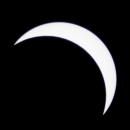
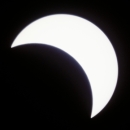
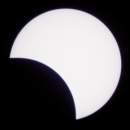
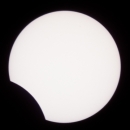
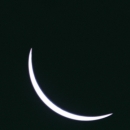
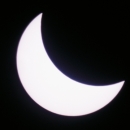
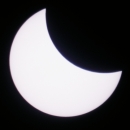
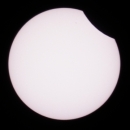
The pictures show the partial phase, 4 before the totality, 4 after the totality.
Equipment
I was using tripod, my Pentax MZ-5 SLR camera, and a borrowed (Thanks Levi) Sigma 600/8 mirror lens and a 2x teleconverter (so it was a 1200/16). Baader Astrosolar filter was attached to the lens.


Preparation
It is relatively easy to prepare for the partial phase since we have to photograph the partial Sun the same way we photograph the full Sun. A partial solar eclipse is an even better preparation.
We have plenty of time to take lots of images using different settings. I was using two rolls of negatives, one before the totality, one after the totality. According to my previous tests 1EV (or even 2EV) overexposure or underexposure is not noticeable.
My exposure time was 1/500s for both rolls. The first roll was an ISO 400 film, the second is an ISO 100 film. I cannot see any differences.
Remarks
- It is surprisingly difficult to find the Sun using the 1200mm lens. First I was searching for the Sun using the 600mm lens and added the focus multiplier after that.
- If you compare the images to the multi exposure image it can be seen the the position of the Moon is not the same. Unfortunately I've positioned the camera incorrectly, the images should be rotated. Next time I should be more careful.
- I had to reposition my camera after only 1 or 2 minutes. Even if I choose a better composition I'd have to reposition it after 3 or 4 minutes. An equatorial mount would have been much better.
Totality, solar wind
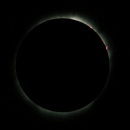
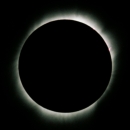
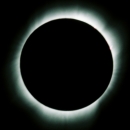
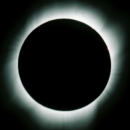
The pictures show the corona. The very high dynamic range cannot be captured on a single image so it's best to create several images using different exposure times.
Equipment
The same equipment without the filter this time. I was using ISO400 negative. Exposure times: 1/1000s, 1/250s, 1/60s, 1/30s.
Preparation
Well, there is no good way to prepare for this. I've created 10 images during the eclipse, the shortest exposure time was 1/1000s the longest was 1/2s. If we need 2-3 seconds for a single image (which is rather slow) we can still create lots of images in the totality (the length of the totality was 3:47 in this case). It seems to me that 1/2s exposure time was way too long.
Diamond ring, Baily's beads
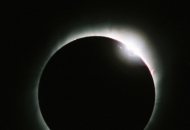
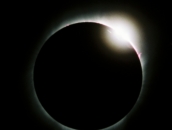
When the Moon almost covers the full Sun the image looks similar to a diamond ring.
Equipment
Exact same as before, no filter of course. ISO400 film, 1/250s.
Preparation
Cannot prepare for this. We have two chances: one before the totality one after the totality. In theory the exact timing can be calculated but it's not too easy to catch the exact moment.
Remarks
- I was using different exposure times before and after totality (1/250s, 1/125s). After checking the pictures I think 1/250s and 1/1000s would have been a better choice.
- I think the optional exposure time changes every second. It explains the fact that webpages suggest different exposure times. Of course I had no time to change the exposure time on the fly.
- Unfortunately the Sun is not totally visible. It was too late to reposition the lens when I've realized it.